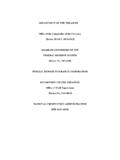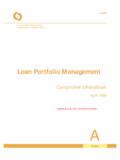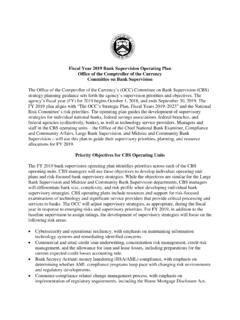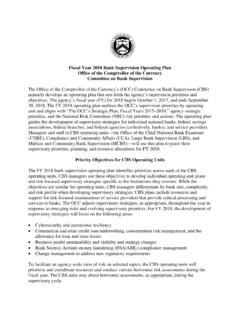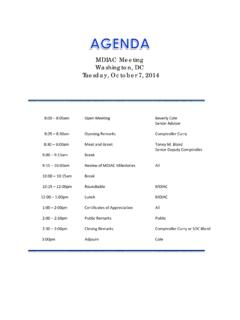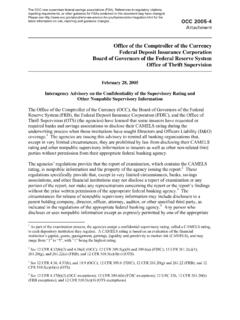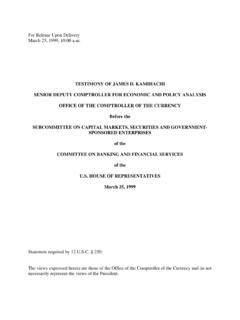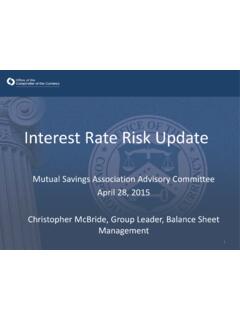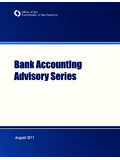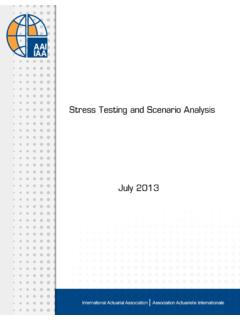Transcription of Principles for Climate-Related Financial Risk Management ...
1 Principles for Climate-Related Financial Risk Management for Large Banks Introduction The Office of the Comptroller of the Currency (OCC) has identified the effects of climate change and the transition to a low carbon economy as presenting emerging risks to banks1 and the Financial Banks are likely to be affected by both the physical risks and transition risks associated with climate change (referred to in these draft Principles as Climate-Related Financial risks). Physical risks refer to the harm to people and property ar ising f rom acute, Climate-Related events, such as hurricanes, wildfires, floods, and heatwaves, and chronic shifts in climate, including higher average temperatures, changes in precipitation patterns, sea level rise, and ocean acidification. Transition risks refer to stresses to certain banks or sectors arising from the shifts in policy, consumer and business sentiment, or technologies associated with the changes necessary to limit climate change.
2 Weaknesses in how banks identify, measure, monitor, and control the potential physical and transition risks associated with a changing climate could adversely affect a bank s safety and soundness, as well as the overall Financial system. Adverse effects could include potentially disproportionate impact on the financially vulnerable, including low- to moderate-income (LMI) and other disadvantaged households and Many banks are considering these risks and would benefit from additional guidance as they develop capabilities, deploy resources, and make necessary investments to address Climate-Related Financial risks. These draft Principles provide a high-level framework for the safe and sound Management of exposures to Climate-Related Financial risks, consistent with the existing risk Management framework described in existing OCC rules and guidance.
3 The Principles are intended to support efforts by banks to focus on key aspects of climate risk Management . The Principles will help bank Management make progress toward answering key questions on exposures and incorporating Climate-Related Financial risks int o banks ris k Management frameworks. Although all banks, r egardless of size, may have material exposures to Climate-Related Financial risks, these draft Principles are targeted at the largest banks, those with over $100 billion in total 1 In this issuance, the term bank refers collectively to national banks, Federal savings associations, and Federal branches or agencies of foreign banking organizations. 2 See Semiannual Risk Perspective at pp. 2-4 (Fall 2021), available at For additional background, see generally Report on Climate-Related Financial Risk, Financial Stability Oversight Council (Oct.)
4 21, 2021) (FSOC Climate Report). 3 For further information, see Staff Reports, Federal Reserve Bank of New York, Understanding the Linkages between Climate Change and Inequality in the United States, No. 991 (November 2021), available at 2 consolidated assets. The OCC is inviting public feedback on the Principles for 60 days, until February 14, 2022. The OCC plans to elaborate on these Principles in subsequent guidance that would distinguish roles and responsibilities of boards of directors (boards) and Management , incorporate the feedback received on the Principles , and consider lessons learned and best practices from the industry and other jurisdictions. In keeping with the OCC s risk-based approach to supervision, the OCC intends to appropriately tailor any resulting supervisory expectations to reflect differences in banks circumstances such as complexity of operations and business models.
5 General Principles Governance. An effective risk governance framework is essential to a bank s safe and sound operation. A bank s board and Management should demonstrate an appropriate understanding of Climate-Related Financial risk exposures and their impact on risk appetite to facilitate oversight. Sound governance includes reviewing information necessary to oversee the bank, allocating appropriate resources, assigning Climate-Related Financial risk responsibilities throughout the organization ( , committees, reporting lines, and roles), and clearly communicating to staff regarding Climate-Related impacts to the bank s risk profile. Responsibility and accountability may be integrated within existing organizational structures or by establishing new structures for Climate-Related Financial risks.
6 Where dedicated units are established, the board and Management should clearly define these units responsibilities and interaction with existing governance structures. The board should have adequate understanding and knowledge to assess the potential impact of Climate-Related risks on the bank and to address and oversee these risks within the bank s strategy and risk appetite, including an understanding of the potential ways in which these risks could evolve over various time horizons and scenarios . Relevant time horizons may include those that extend beyond the bank s typical strategic planning horizon. The board should actively oversee the bank s risk-taking activities and hold Management accountable for adhering to the risk governance framework. Management is responsible for executing the bank s overall strategic plan.
7 This responsibility includes effectively managing all risks, including Climate-Related Financial risks, and their effects on the bank s Financial condition. Management should also hold staff accountable for controlling risks within established lines of authority and responsibility. Additionally, Management is responsible for regularly reporting to the board on the level and nature of risks to the bank, including Climate-Related Financial risks. Policies, Procedures, and Limits. Management should incorporate Climate-Related risks into policies, procedures, and limits to provide detailed guidance on the bank s approach to these risks in line with the strategy and risk appetite set by the board. Policies, procedures, and limits should be modified when necessary to reflect the distinctive characteristics of Climate-Related risks and changes to the bank s activities.
8 Strategic Planning. The board and Management should consider material Climate-Related Financial risk exposures when setting the bank s overall business strategy, risk appetite, and Financial , capital, and operational plans. As part of forward-looking strategic planning, the board and Management should address the potential impact of Climate-Related Financial risk exposures on the bank s Financial condition, operations (including geographic locations), and business 3 objectives over various time horizons. The board and Management should also consider Climate-Related Financial risk impacts on stakeholders expectations, the bank s reputation, and LMI and other disadvantaged households and communities, including physical harm or access to bank products and services. The OCC recognizes that the incorporation of material Climate-Related Financial risks into various planning processes is iterative as measurement methodologies, models, and data for analyzing these risks continue to evolve and mature over time.
9 Any Climate-Related strategies, including any relevant corporate social responsibility objectives, should align with and support the bank s broader strategy, risk appetite, and risk Management framework. In addition, where banks engage in public communication of their Climate-Related strategies, boards and Management should ensure that any public statements about their banks Climate-Related strategies and commitments are consistent with their internal strategies and risk appetite statements. Risk Management . Climate-Related Financial risks typically impact banks through a range of traditional risk types. Management should oversee the development and implementation of processes to identify, measure, monitor, and control Climate-Related Financial risk exposures within the bank s existing risk Management framework.
10 A bank should employ a comprehensive process to identify emerging and material risks stemming from the bank s business activities and associated exposures. The risk identification process should include input from stakeholders across the organization with relevant expertise ( , business units, independent risk Management , and legal). Risk identification includes assessment of Climate-Related Financial risks across a range of plausible scenarios and under various time horizons. As part of sound risk Management , banks should develop processes to measure and monitor material Climate-Related Financial risks and to inform Management about the materiality of those risks. Material Climate-Related Financial risk exposures should be clearly defined, aligned with the bank s risk appetite, and supported by appropriate metrics ( , risk limits and key risk indicators) and escalation processes.
